Wisconsin Nitrate Film Project
One of the chief difficulties of conducting research on nitrate film is the lack of available of samples. The methods of analysis required to study the physical and chemical behavior of cellulose nitrate require destruction of the film, yet the bulk of nitrate films held in archival collections are rare and unique historical artifacts.
Following a review of its film holdings in 2010 and 2011, however, the conservation staff at the Wisconsin Center for Film and Theater Research (WCFTR) and the Wisconsin Historical Society (WHS) deaccessioned a number of reels of 35mm nitrate film, all manufactured by Eastman Kodak before 1951. Instead of disposing of these materials, they agreed to donate seven of them to the Wisconsin Nitrate Film Project. This provided us with the primary sample materials on which we performed our chemical analysis.
In selecting among the deaccessioned films, we were guided by the five–stage process of decay commonly used by archivists when assessing their nitrate collections. As described by the National Film Preservation Foundation’s Film Preservation Guide (2004), this process is as follows:
- Stage 0: Film exhibits no signs of decay
- Stage 1: Image fading. Brownish discoloration of emulsion. Faint noxious odor.
- Stage 2: Sticky emulsion. Faint noxious odor.
- Stage 3: Emulsion softens and blisters with gas bubbles. More pungent odor.
- Stage 4: Film congeals into a solid mass. Strong noxious odor.
- Stage 5: Film disintegrates into a brownish power.

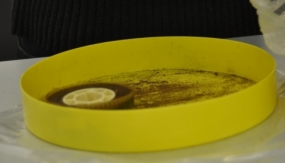
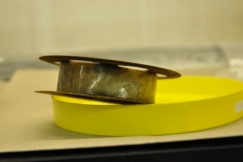
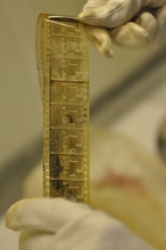
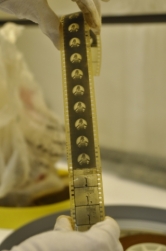
For the most part, this five–stage process is described consistently across the literature on nitrate film, but there are some contradictions. Most significantly, while most sources claim that combustibility increases in the latter stages of decomposition, a few – such as the International Organization for Standardization’s ISO 10356: Cinematography – Storage and Handling of Motion Picture Films (most recent edition 2012) – assert that films in Stage 4 or Stage 5 are actually less dangerous. The five stages are also not ascribed with any concrete timeline, making it difficult for archivists to determine how quickly a film will reach Stage 5 once it has started to decay.
Given the importance of the five–stage process to archival practices and the disparities that exist in how this process is described, we decided to use this model as our starting point when selecting our film samples. By running chemical tests on samples in different stages of decay, we hoped to determine whether this visual classification process actually correlates with severity of decay and combustibility.
Heritage Nitrate Film Samples
Of the available deaccessioned film reels, we selected three that reprsented noticeably different stages. Each sample was labeled with CN (Cellulose Nitrate) and a number corresponding to its stage of decomposition. We cut individual frames from each of these reels to use in our physiochemical analyses.
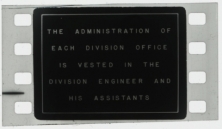 CN-0 is dated 1935 (Kodak +■) and is in nearly pristine condition, aligning it with Stage 0. This reel, labeled “Wisconsin Highway Film Titles,” consists of intertitles describing highway construction and administration. The condition of the film on this reel was relatively uniform and sample frames were taken consecutively.
CN-0 is dated 1935 (Kodak +■) and is in nearly pristine condition, aligning it with Stage 0. This reel, labeled “Wisconsin Highway Film Titles,” consists of intertitles describing highway construction and administration. The condition of the film on this reel was relatively uniform and sample frames were taken consecutively.
 CN-2 is dated 1919 (Kodak ··) and exhibits the yellowing of the base, slightly sticky emulsion, and faint noxious odor characteristic of Stage 2. With the aid of the Library of Congress, we identified this film as Chickens in Turkey (1919), a two–reel comedy starring Dorothy Earle and Marcel Perez. The condition of the film on this reel was also relatively uniform and sample frames were taken consecutively.
CN-2 is dated 1919 (Kodak ··) and exhibits the yellowing of the base, slightly sticky emulsion, and faint noxious odor characteristic of Stage 2. With the aid of the Library of Congress, we identified this film as Chickens in Turkey (1919), a two–reel comedy starring Dorothy Earle and Marcel Perez. The condition of the film on this reel was also relatively uniform and sample frames were taken consecutively.
 CN-4 is dated 1919 (Kodak ··) and large portions of this reel had congealed into the malodorous, yellow mass characteristic of Stage 4. It is possible that this is the second reel of Chickens in Turkey. The quality of the film on this reel varied, with some portions of the reel congealed and completely devoid of emulsion and others in relatively good condition. For this reason, when selecting individual frames from this reel for chemical analysis, we chose those that were comparable in terms of their stage of decay, rather than taking them consecutively, as we did with our other samples.
CN-4 is dated 1919 (Kodak ··) and large portions of this reel had congealed into the malodorous, yellow mass characteristic of Stage 4. It is possible that this is the second reel of Chickens in Turkey. The quality of the film on this reel varied, with some portions of the reel congealed and completely devoid of emulsion and others in relatively good condition. For this reason, when selecting individual frames from this reel for chemical analysis, we chose those that were comparable in terms of their stage of decay, rather than taking them consecutively, as we did with our other samples.
The dates ascribed to our samples derive from a combination of the edge codes printed on the film stock (visible on the image above for CN-2) and provenancial information from WCFTR and WHS. The date refers to when the stock was manufactured, not when the film was produced.
In total, we tested approximately 115 frames of the CN-0 film, and approximately 45 frames of the CN-2 and CN-4 films.
Brown Powder Samples
We also wanted to investigate the potentially hazardous nature of the “brown powder” that arises in the final stages of cellulose nitrate decomposition, as literature and anecdotes about the powder stage are particularly contradictory. Some, such as such the International Organization for Standardization’s ISO 10356: Cinematography – Storage and Handling of Motion Picture Films (most recent edition 2012), maintain that the powder is relatively inert, with flammability comparable to paper. Others, however, most notably Eastman Kodak’s legal Material Safety Data Sheet (most recent edition 2010), claim that the brown powder is “shock sensitive,” like gunpowder or nitroglycerine.
The degree of danger posed by brown powder significantly affects how curators of nitrate collections handle and dispose of film stocks that have degraded beyond any useful condition. We therefore sought to quantitatively evaluate this substance’s shock and friction sensitivity.
For these shock and friction tests, which were conducted by the safety services firm Chilworth Technology, Inc., we obtained four samples of Stage 5 brown powder from two geographically diverse major film archives.
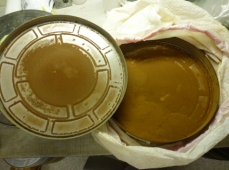
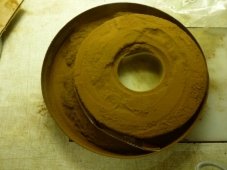
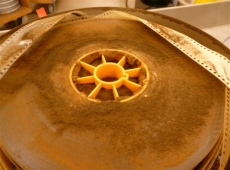
Sample 1 was of unknown provenance. Sample 2 was dated from 1929, manufacturer unknown. Sample 3 was dated 1937, and was likely manufactured by Eastman Kodak. Sample 4 was also of unknown provenance. These samples were specifically chosen due their variable provenance and to the fact that the shock and friction sensitivity tests required a minimum of five (5) grams of brown powder. All samples arose from the decay of nitrate film stored according to current best practices for archival storage and handling.
The details of these tests can be found on the Brown Powder page of this website.
